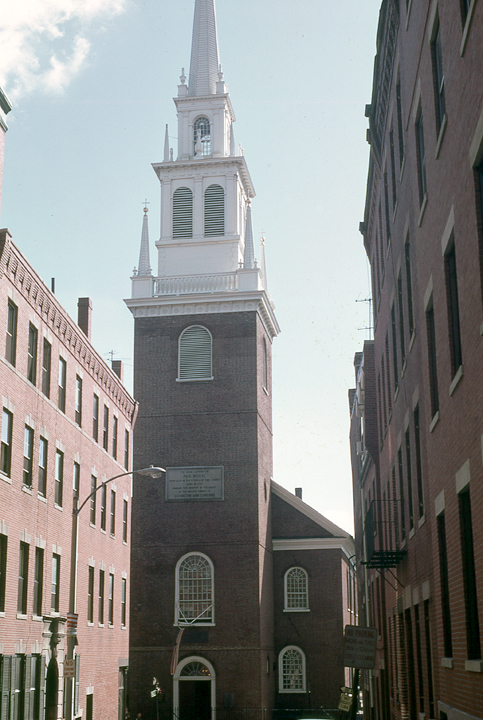September 1698: "Founded
in 1722, Christ Church in the City of Boston, known to all as the Old
North Church,
is Boston’s oldest surviving church building and one of its most visited
historical sites."
"The Old North Church was built in 1723, and was
inspired by the works of Christopher Wren, the British architect who
was responsible for rebuilding London after the Great Fire."
"In April 1775, Paul Revere told three Bostonpatriots
to hang two lanterns in the steeple. These men were the church
sexton Robert Newman and Captain John Pulling—the two of whom historian
David Hackett Fischer suggests each
carried one lantern up to the steeple—as well as Thomas Bernard, who
stood watch for British troops outside the church.
The lanterns were displayed to send a warning to Charlestown patriots
across the Charles River about the movements
of the British Army. Revere and William Dawes would later deliver the
same message to Lexington themselves, but this
lantern method was a fast way to inform the back-up riders in
Charlestown about the movements of the British; these
back-up riders planned to deliver the warning message to Lexington and
Concord in case Revere and Dawes were
arrested on the way.
The lanterns were hung for just under a minute to avoid catching
the eyes of the British troops occupying Boston, but
this was long enough for the message to be received in Charlestown. The
militia waiting across the river had been told
to look for the signal lanterns, and were prepared to act as soon as
they saw them.
The meaning of two lanterns has been memorized by countless
American schoolchildren. "One if by land, and two if by
sea" is from Henry Wadsworth Longfellow's poem "Paul Receres's Ride".
One lantern was to notify Charlestown that
the British Army would march over Boston Neck and the Great Bridge, and
two were to notify them that the troops
were taking boats across the Charles River to land near Phips farm.
After receiving the signal, the Charlestown Patriots
sent out a rider to Lexington, but this rider did not reach his
destination and his identity has disappeared from history.
He was the one who might have been captured by a British patrol.
But the warning was delivered miles away to dozens of towns, first
by Revere and Dawes on horses, and then by other
men on horses and men who rang church bells and town bells, beat drums,
and shot off warning guns." |
